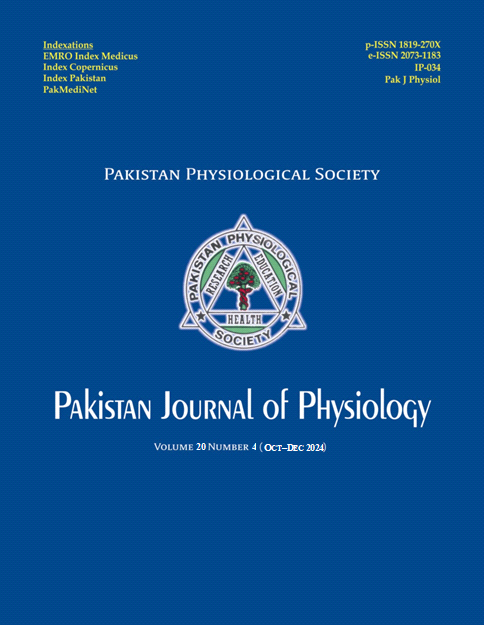HISTOPATHOLOGICAL EVALUATION OF EFFECTS OF CURCUMIN AND ALOE VERA GEL ON CUTANEOUS WOUND HEALING IN ALBINO WISTAR RATS
DOI:
https://doi.org/10.69656/pjp.v20i4.1652Keywords:
Skin, Wound Healing, Curcumin, Aloe veraAbstract
Background: Healing is a survival process and essential for maintaining normal anatomical structure and function. Curcumin, the primary active compound in turmeric, and aloe vera, possess notable antioxidant and antimicrobial properties which aid in healing. Objective of this study was to investigate the effects of curcumin and aloe vera on cutaneous wound healing. Methods: This experimental study was conducted in Department of Pathology, Isra University, Hyderabad, from January to July 2023. Sixty-four healthy albino Wistar rats weighing 150–250 grams were procured from Sindh Agriculture University, Tando Jam. A full-thickness open excision-type wound was created and animals were divided into Group A (Control group, petroleum jelly applied to wound), Group B (Turmeric paste was applied on wound), Group C (aloe vera gel applied to wound), and Group D (Turmeric and aloe vera applied to wound). Four animals from each group were sacrificed on day 3, 5, 10, and 14 respectively. An excisional biopsy was taken and sections were examined for histological changes. Results: Markers of cutaneous wound healing such as congested blood vessels, inflammatory cells, number of fibroblasts, and amount of collagen deposition were best seen in Group D (p<0.05). Group D also showed the earliest signs of wound healing (p<0.05). Group A, B, and C showed some changes as congested blood vessels and inflammatory cells with signs of wound healing later. Conclusion: Combination therapy of curcumin and aloe vera exhibits better healing properties than individual therapy with either drug.
Pak J Physiol 2024;20(4):13?6 DOI: https://doi.org/10.69656/pjp.v20i4.1652
Downloads
References
Tottoli EM, Dorati R, Genta I, Chiesa E, Pisani S, Conti B. Skin wound healing process and new emerging technologies for skin wound care and regeneration. Pharmaceutics 2020;12(8):735.
Shedoeva A, Leavesley D, Upton Z, Fan C. Wound healing and the use of medicinal plants. Evid Based Complement Alternat Med 2019;2019:2684108.
Ansari L, Mashayekhi?Sardoo H, Baradaran Rahimi V, Yahyazadeh R, Ghayour?Mobarhan M, Askari VR. Curcumin?based nanoformulations alleviate wounds and related disorders: A comprehensive review. Biofactors 2023:49:736–81.
Riha SM, Maarof M, Fauzi MB. Synergistic effect of biomaterial and stem cell for skin tissue engineering in cutaneous wound healing: A concise review. Polymers (Basel) 2021;13(10):1546.
Awuchi CG. Medicinal plants: the medical, food, and nutritional biochemistry and uses. Int J Adv Acad Res 2019;5(11):220–41.
El-Saadony MT, Zabermawi NM, Zabermawi MA, Burollus ME, Shafi MA, Alagawany M, et al. Nutritional aspects and health benefits of bioactive plant compounds against infectious diseases: a review. Food Rev Int 2023;39(4):2138–60.
Kebede BH, Forsido SF, Tola YB, Astatkie T. Free radical scavenging capacity, antibacterial activity and essential oil composition of turmeric (Curcuma domestica) varieties grown in Ethiopia. Heliyon 2021;7(2):e06239.
Chaturvedi M, Rani R, Sharma D, Yadav JP. Comparison of Curcuma caesia extracts for bioactive metabolite composition, antioxidant and antimicrobial potential. Nat Prod Res 2021;35(18):3131–5.
Saleem A, Naureen I, Naeem M, Murad HS, Maqsood S, Tasleem G. Aloe vera gel effect on skin and pharmacological properties. Sch Int J Anat Physiol 2022;5(1):1–8.
Fatmawati CN, Retnaningtyas E, Wahyuni TD. The effect of aloe vera toward the number of fibroblasts on the wound incision of wistar rats (Ratus Norvegicus). J Vocat Nurs 2020;1(1):30–6.
Sánchez M, González-Burgos E, Iglesias I, Gómez-Serranillos MP. Pharmacological update properties of aloe vera and its major active constituents. Molecules 2020;25(6):1324.
Arif S, Attiogbe E, Moulin VJ. Granulation tissue myofibroblasts during normal and pathological skin healing: The interaction between their secretome and the microenvironment. Wound Repair Regen 2021;29(4):563–72.
Aitcheson SM, Frentiu FD, Hurn SE, Edwards K, Murray RZ. Skin wound healing: normal macrophage function and macrophage dysfunction in diabetic wounds. Molecules 2021;26(16):4917.
Aware CB, Patil DN, Suryawanshi SS, Mali PR, Rane MR, Gurav RG, et al. Natural bioactive products as promising therapeutics: A review of natural product-based drug development. S Afr J Bot 2022;151:512–28.
Chittasupho C, Manthaisong A, Okonogi S, Tadtong S, Samee W. Effects of quercetin and curcumin combination on antibacterial, antioxidant, in vitro wound healing and migration of human dermal fibroblast cells. Int J Mol Sci 2021;23(1):142.
Liang J, Cui L, Li J, Guan S, Zhang K, Li J. Aloe vera: a medicinal plant used in skin wound healing. Tissue Eng Part B Rev 2021;27(5):455–74.
Yazarlu O, Iranshahi M, Kashani HRK, Reshadat S, Habtemariam S, Iranshahy M, et al. Perspective on the application of medicinal plants and natural products in wound healing: A mechanistic review. Pharmacol Res 2021;174:105841.
Chen S, Liang H, Ji Y, Kou H, Zhang C, Shang G, et al. Curcumin modulates the crosstalk between macrophages and bone mesenchymal stem cells to ameliorate osteogenesis. Front Cell Dev Biol 2021;9:634650.
Lin TK, Zhong L, Santiago JL. Anti-inflammatory and skin barrier repair effects of topical application of some plant oils. Int J Mol Sci 2017;19(1):70.
Rahman S, Carter P, Bhattarai N. Aloe vera for tissue engineering applications. J Funct Biomater 2017;8(1):6.
Salehi B, Lopez-Jornet P, Pons-Fuster López E, Calina D, Sharifi-Rad M, Ramírez-Alarcón K, et al. Plant-derived bioactives in oral mucosal lesions: a key emphasis to curcumin, lycopene, chamomile, aloe vera, green tea and coffee properties. Biomolecules 2019;9(3):106.
Shafaie S, Andalib S, Shafaei H, Montaseri A, Tavakolizadeh M. Differential biological behavior of fibroblasts and endothelial cells under aloe vera gel culturing. Int J Mol Cell Med 2020;9:234–46.
Downloads
Published
How to Cite
Issue
Section
License

This work is licensed under a Creative Commons Attribution-NoDerivatives 4.0 International License.
The author(s) retain the copyrights and allow their publication in Pakistan Journal of Physiology, Pak J Physiol, PJP to be FREE for research and academic purposes. It can be downloaded and stored, printed, presented, projected, cited and quoted with full reference of, and acknowledgement to the author(s) and the PJP. The contents are published with an international CC-BY-ND-4.0 License.












